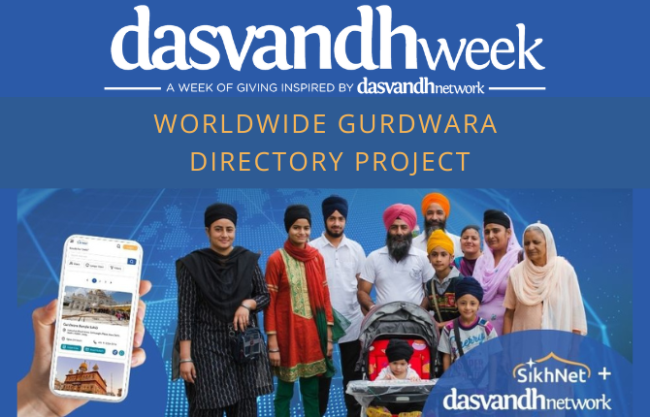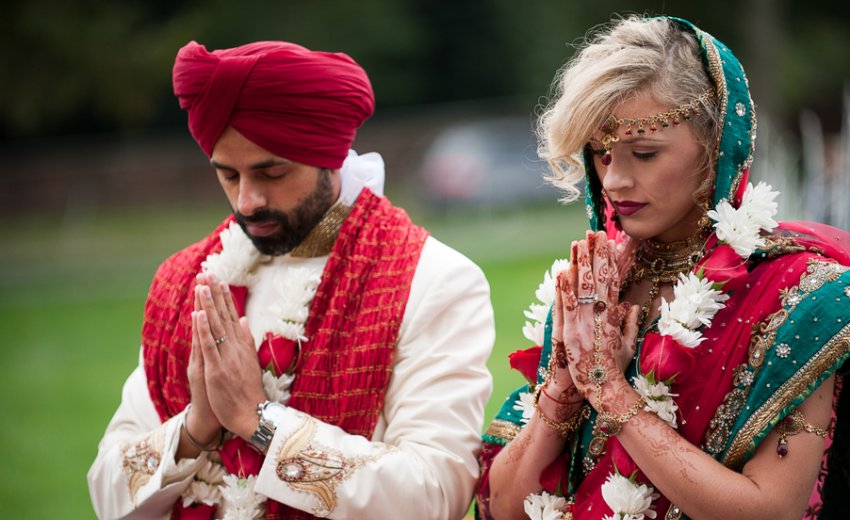I recently attended several marriages where the participants were of different faiths. In two of them the groom was a Sikh and in one the bride was a Sikh. All of them were conducted outside a Gurdwara – probably because the couples, their parents or the Gurdwara authorities were uneasy, and this started me thinking as to where we are headed.
There has been much controversy recently with groups in the United Kingdom forcibly preventing such inter- faith marriages. They rely, correctly, on the Sikh Rehat Maryada (SRM) which only allows the Anand Karaj between two Sikhs. The SRM is silent on other aspects of the Anand Karaj though. Can it be done between two same-sex individuals? Is the Anand Karaj the “right” of all Sikhs – even if those Sikhs have not followed the path of Sikhi, have never attended Gurdwara functions, nor kept the five kakkars, or are not Amritdhari? What is the legal basis to prevent someone who wishes to marry by the Anand Karaj ceremony? With rising numbers of Sikhs in the diaspora, we are going to be facing these issues with increasing frequency and a response based on Gurmat and existing secular laws needs to be developed.
The Sikh Anand Karaj is a religious ceremony. It signifies a union between two souls. There are several places in the Sri Guru Granth Sahib Ji that refer to a wedding – but they mostly refer to it as a spiritual union. The human soul (the atma) is the metaphorical bride seeking union with her husband (who is the Parmatama – oversoul.) The Laavan (wedding hymn) refers to four stages of spiritual evolution as the souls unite. There is to be no differentiation here of the status of the bride, and she is to be treated as an equal. We have seen weddings where the bride wore the “bana” and carried a Kirpan, just as the groom did.
In the early days of Sikhi, there was no Anand Karaj ceremony. Guru Nanak Dev Ji refused to marry by going around the ritual fire and is reputed to have gone around the “Ek Onkar” symbol. The Laavan (or the wedding hymns) were written later by Guru Ram Das Ji, our Fourth Guru. Until the later part of the 19th century, the traditional Sikh wedding was still done with Hindu features. This “Vedi Vivah” was performed in the household of Maharaja Ranjit Singh. Several elders whom I have talked to, recall that their parents told them of being married in this way in the presence of the Sri Guru Granth Sahib. In this ceremony the four rounds of the lavaan were preformed around a “vedi” containing a ritual fire.
It was the founder of the Nirankari movement Baba Dayal ji (1773–1855), who started the tradition of the four lavaan around the Sri Guru Granth Sahib. In 1808 A.D. he was married with Shabad-Kirtan and Ardas in the Dharamsala of Sant Budhu Shah, a Sewa Panthi, in Bhera, which is now in Pakistan. (This is mentioned by Dr. Man Singh Nirankari in “Baba Dayal ji Nirankari– Sikh Dharam De Sidhant” - Pages 48 to 53.) We also understand that the circling the Sri Guru Granth Sahib does not have any particular religious sanction and may have been adopted as a response to Hindu traditions.
Baba Dayal Ji’s children later adopted this ceremony and it became established in the Nirankari movement as the standard marriage ceremony by the 1860s. This Lavaan ceremony received a major push when the Anand Marriage Act was adopted by the Imperial Legislative Council in Oct, 1909. Sikh marriage rites were thus legally recognized for the first time and it slowly became the standard Sikh Wedding ceremony that we see today.
With the arrival of the Sikh Rehit Maryada (SRM) approved by the Shiromani Gurdwara Parbandhak Committee, Amritsar in 1945, new rules were made. These restricted the Sikh Anand Karaj only to those couples who were both Sikhs. The relevant portions of the SRM are:
Article XVIII …
“b. A Sikh's daughter must be married to a Sikh...”
e. When a girl becomes marriageable, physically, emotionally and by virtue of maturity of character, a suitable Sikh match should be found, and she should be married to him by Anand marriage rites.”
k. Persons professing faiths other than the Sikh faith cannot be joined in wedlock by the Anand Karaj ceremony.”
Taken at face value, these passages prohibit the marriage of a Sikh to a non- Sikh.
We need to look upon this from at least two points of view. First, is this unusual among the other faith systems of the world?
In Islam, Muslim women are forbidden from marrying non-Muslim men according to Islamic law. In some countries any non-Muslim person who wishes to marry a Muslim, must first convert to Islam before they can even apply to get married.
In Orthodox Judaism interfaith marriages cannot be performed in their synagogues, nor do they allow their rabbis to perform interfaith marriages. If they still wish to marry, then the non-Jewish person will have to convert to Judaism – a process that can take a year.
Among Catholics, the standard line is that marriage to a non-Catholic is not allowed. One must get a “dispensation” from the local bishop to marry a non-Catholic person.
With this in mind, the Sikh position on Sikhs marrying non-Sikhs is not unusual. Of course, there are benefits from this approach. It promotes a Sikh ethos and allows Sikhs to claim ownership of their own religious ceremonies. It promotes the transmission of the faith to future generations, as it was more likely to be done when both the husband and wife are Sikhs. It also makes clear that this is a religious sacrament and not to be entered into lightly.
But let us look at this from another point of view. Does it follow the teachings of the Guru Granth Sahib? The message of the lavaan is for the merger with a higher spiritual being, and marriage is used as a metaphor for seeking the merger. Such a message is gender neutral and faith neutral and there is no prohibition in the Sri Guru Granth Sahib against marrying a person of another faith.
The SRM was written by older Sikh males in the 1930’s and 1940’s. Theirs was a very conservative view of society and religion. Punjab at that time was a part of British Colonial India and they tended to follow established customs or norms without too much questioning. There is no mention in the preamble to the SRM that the opinion of youth or women was sought. (However, this is completely understandable given the cultural milieu of those times.)
But there has been significant change in society since then. Many more people are educated and can look at issues through the lens of modern experiences. Religion has lost the absolute power that it had in the 18 and 19th centuries. Is it therefore right to enforce the values of that earlier era on the newer generations? Although the conservatives, would like to keep the traditions and “sacred” customs, how does that square with the teachings of the faith about equality and the respect for other faiths?
Unfortunately, these SRM rules have also allowed a lot of hypocrisy to creep in. There are Sikh boys and girls who do not profess any knowledge of Sikhi. They are led through their Anand Karaj with no idea of what they are doing. They receive no instructions or religious counselling. Often, they have not even been inside a Gurdwara. They are “cultural” Sikhs, and many are not kesadhari. Is it fair then to prevent a Sikh from marrying a non-Sikh partner if he/she has as much knowledge or commitment to Sikhi? It also downplays the role of marriage as a Social Contract – asserting that it is only a religious contract and thus a non-Sikh is not eligible.
And now we have to approach the emerging issue of same-sex marriage. Again, the Sri Guru Granth Sahib Ji and the SRM are silent on this. Conservative Sikhs have expressed strong views against same-sex marriages, but they can only back up their stands based on “tradition” and “custom” and seem to ignore the lines in the SGGS that promote equality.
There are also quotes in Gurbani where discrimination on the basis of caste is forbidden. One must ask the hypothetical question then: How would our Gurus have approached and treated an LGBT person in those times. Would they have shunned him/her, or would they have treated them with love and care as another soul, deserving the grace and mehar of Waheguru?
The answers to these questions are not easy, and it is hard to posit solutions to these difficult problems here. These require deliberations of wise people in a systematic fashion but these deliberations cannot be done under threats, or pressures from the various “jathebandis.” Those who are proposing changes have a right to be heard. They are Sikhs, and they have genuine questions about these issues where the SRM is either silent, or contains rules that run counter to the principles contained in the Sri Guru Granth Sahib Ji.
The sad reality is however that our institutions (the Akal Takht, the SGPC) have become so corroded and corrupt that we cannot imagine that they will make any serious attempt to render an impartial view on this. Politics will rear its ugly head, and factions that propose one point of view (generally the conservative or “no change” faction) will clash with those wishing for change. Often, they do this less, on the basis of issues raised, and more to score political points and take their opponents down.
Viable options include allowing a non-Sikh to be married with an Anand Karaj ceremony provided he/she has undertaken several commitments. Some time may be allotted to fulfilling these obligations. There may be statements that will need to be made regarding the faith of children. If this path is chosen, there will need to be a method to monitor if these obligations were fulfilled. A position paper on same sex marriage will need to be prepared and discussed.
If the Akal Takht does not tackle these issues, it may perhaps be necessary to discuss these issues outside the Akal Takht or SGPC. This could be done at a respectable Taksaal, or with a Gurdwara Parbhandak Committee in another location. This may even have to be conducted outside India. Different viewpoints will need to be sought from Sikh intellectuals, politicians and legal scholars. There will be repercussions for sure, but if the Sikhs in Amritsar are not providing guidance, then others may have to. We cannot sit idly by as society changes and pronounce the SRM as unchangeable. The SRM was developed by Sikhs of a particular era and mindset. The viewpoints of the newer and future Sikhs will now have to be seriously pondered and considered.
~ Gurpal Singh Bhuller ([email protected])
photographer, Amber Wilkie

